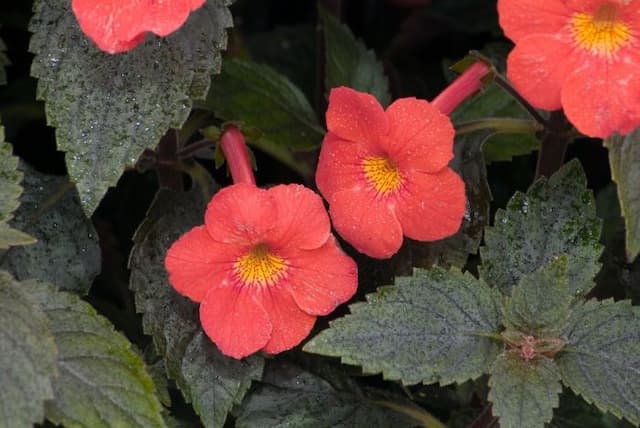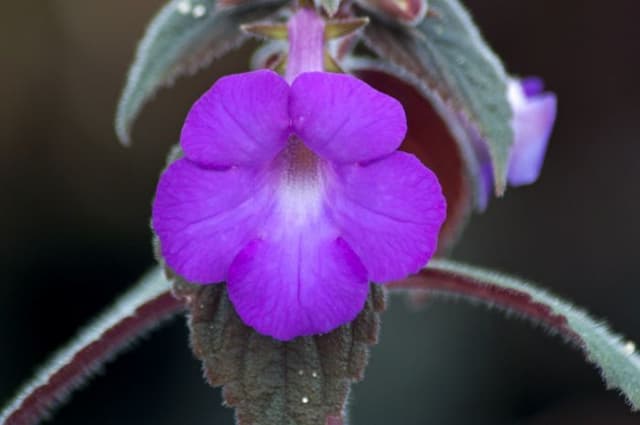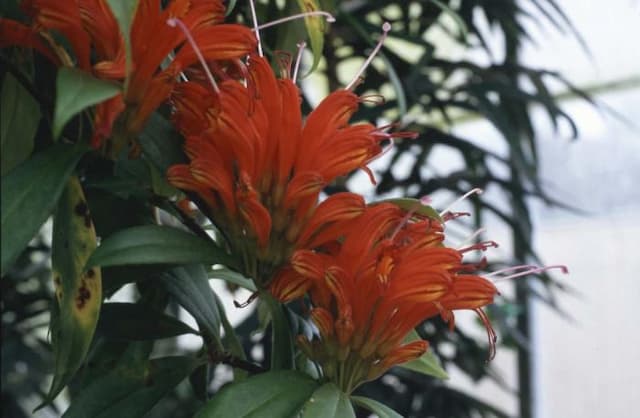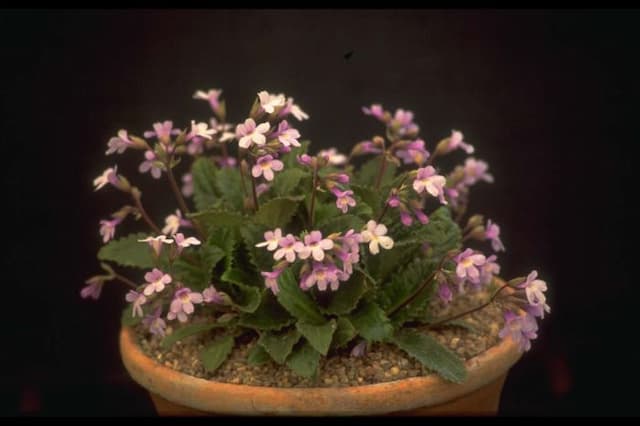Cape primrose 'Polka-Dot Red' Streptocarpus 'Polka-dot Red'

ABOUT
'Polka-Dot Red' is a compact, tender, perennial with strappy, mid green, hairy leaves. Tubular flowers with spreading lobes up to 5.5cm across are a deep pinkish-red with white edging and speckling and are borne in profusion over a long season
About this plant
 Names
NamesFamily
Gesneriaceae.
Synonyms
Cape Primrose, African Violet.
Common names
Streptocarpus 'Polka-dot Red'.
 Characteristics
CharacteristicsLife cycle
Perennials
Foliage type
Evergreen
Color of leaves
Green
Flower color
Red
Height
1 foot (30 cm)
Spread
1 foot (30 cm)
Plant type
Herb
Hardiness zones
10
Native area
South Africa
Benefits
 General Benefits
General Benefits- Easy to care for – Streptocarpus is low maintenance and can thrive indoors with minimal care.
- Long blooming period – It has the ability to bloom for months on end, providing a long-lasting display of flowers.
- Attractive foliage – The leaves are a feature in themselves, often large and textured, adding to the plant's decorative appeal.
- Compact size – It stays relatively small, making it ideal for indoor spaces and windowsills.
- Wide variety of colors – Offers a range of colors and patterns, with 'Polka-dot Red' being a particularly vibrant choice.
- Ideal for containers – Can be grown in pots, hanging baskets, or planters, offering versatility in how it's displayed.
- Non-toxic to pets – Safe to have in a home with cats and dogs, as it is not known to be toxic to pets.
 Medical Properties
Medical PropertiesThis plant is not used for medical purposes.
 Air-purifying Qualities
Air-purifying QualitiesThis plant is not specifically known for air purifying qualities.
 Other Uses
Other Uses- Photography Projects: The Streptocarpus 'Polka-dot Red', with its bright colors and unique patterns, provides a stunning subject for photographers, particularly those interested in macro photography.
- Teaching Tool: This plant can be used in biology classes to teach students about pollination and the reproductive systems of flowering plants, as it has distinct male and female parts that are easily observable.
- Aesthetic Enhancement for Aquatic Displays: While not an aquatic plant, it can be placed in pots around aquariums to complement the underwater scenery and create a cohesive, vibrant environment.
- Culinary Garnish: Carefully washed leaves and flowers of the Streptocarpus 'Polka-dot Red' can be used as an ornamental garnish for special dishes due to their unique appearance, though they are not typically consumed.
- Art Inspiration: Artists can draw inspiration from the complex patterns and colors of the Streptocarpus 'Polka-dot Red' for paintings, textile designs, and other artistic creations.
- Botanical Illustration: Plant enthusiasts and botanists may use this variety of Streptocarpus as a subject for detailed botanical illustrations, emphasizing the beauty of its foliage and flowers.
- Theme Gardens: Gardeners could design a 'polka-dot' themed garden, featuring Streptocarpus 'Polka-dot Red' alongside other spotted plants, to create a playful and cohesive garden design.
- Educational Collections: Botanic gardens and educational institutions may use this plant as part of their collections to demonstrate the diversity within the Streptocarpus genus.
- Feng Shui: According to the principles of Feng Shui, vibrant flowering plants like Streptocarpus 'Polka-dot Red' can be used to enhance the energy of a home or office space.
- Social Media Content: Plant enthusiasts can feature Streptocarpus 'Polka-dot Red' in their social media to engage audiences with its striking appearance and contribute to online plant appreciation communities.
Interesting Facts
 Feng Shui
Feng ShuiThe Cape Primrose is not used in Feng Shui practice.
 Zodiac Sign Compitability
Zodiac Sign CompitabilityThe Cape Primrose is not used in astrology practice.
 Plant Symbolism
Plant Symbolism- Persistence: Streptocarpus plants, also known as Cape Primrose, often symbolize persistence due to their ability to bloom for several months with proper care.
- Enduring Beauty: Cape Primrose's long-lasting flowers represent enduring beauty, conveying a message of lasting appreciation and admiration.
- New Beginnings: With their frequent blooming cycles, Cape Primroses can also be associated with new beginnings and fresh starts.
- Hope: The vibrant blooms of Cape Primrose amidst lush foliage can signify hope and the positive expectation of things to come.
 Water
WaterCape Primrose prefers to be watered when the top inch of soil feels dry to the touch. It is best to water this plant from the bottom to prevent water from getting on the leaves and causing damage. To do this, place the pot in a tray filled with 1 to 2 inches of water and allow the plant to soak up moisture for about 30 minutes to an hour. Check the plant weekly, but the frequency of watering can vary from once a week to once every two weeks, depending on the humidity and temperature of your environment. A general guideline is to provide about 8-16 ounces of water per week, ensuring that the soil remains evenly moist but not waterlogged.
 Light
LightCape Primrose thrives in bright, indirect light. It should be placed in a spot where it receives plenty of light without being subjected to the harsh rays of direct sunlight, which can scorch its leaves. East or north-facing windows are typically the best spots, offering ample light without the intensity of the midday sun. Avoid placing it in too much shade, as this can lead to leggy growth and fewer flowers.
 Temperature
TemperatureCape Primrose performs best in temperatures between 60 and 75 degrees Fahrenheit. The plant can survive minimum temperatures down to about 50 degrees Fahrenheit but should not be exposed to temperatures below this, as it can result in cold damage. Similarly, the plant should be protected from temperatures exceeding 80 degrees Fahrenheit, which could stress the plant and impair its growth and flowering.
 Pruning
PruningPruning Cape Primrose involves removing fading or dead flowers to encourage the production of new blooms and to maintain the plant's aesthetic appeal. Additionally, any yellowing or dead leaves should be removed to prevent potential disease issues. Pruning is best done as needed throughout the flowering season, typically from spring to fall. The ideal time for major pruning is early spring, just as the plant begins to grow after its winter rest.
 Cleaning
CleaningAs needed
 Soil
SoilCape Primrose 'Polka-dot Red' requires a well-draining soil mix with high organic matter. It thrives best in slightly acidic to neutral pH levels, between 5.5 and 7.0. A mix of peat, perlite, and loam is often recommended for this plant to ensure good drainage and moisture retention.
 Repotting
RepottingCape Primroses should be repotted once a year or when they outgrow their pots. The best time to repot is in the spring or early summer when the plants are starting their active growth phase.
 Humidity & Misting
Humidity & MistingCape Primrose 'Polka-dot Red' prefers moderate to high humidity levels, ideally between 50% and 70%. They thrive in a humid environment but should not be subjected to wet foliage to prevent fungal issues.
 Suitable locations
Suitable locationsIndoor
Provide bright, indirect light and consistent moisture.
Outdoor
Shelter from direct sun; keep in a humid, shaded spot.
Hardiness zone
10-11 USDA
 Life cycle
Life cycleThe life of a Cape Primrose 'Polka-dot Red' begins with seed germination, which requires a warm environment and usually occurs within a few weeks after sowing. After sprouting, the seedlings will develop their first set of true leaves, a sign they are ready to be gently transplanted if necessary. The vegetative growth stage follows, where the plant grows stems and large, velvety leaves, and must be kept in moderate to bright, indirect light to avoid scorching. The next stage is flowering, where 'Polka-dot Red' produces its characteristic red flowers with polka dots, generally stimulated by shorter daylight hours. After flowering, pollination can occur, potentially producing seed pods if pollinators are present or if manually pollinated. When the plant's lifecycle is complete, it will start to drop leaves and decline, although Cape Primroses can be long-lived with proper care, and they can also be propagated via leaf cuttings to start new plants.
 Propogation
PropogationPropogation time
Spring-Early Summer
Propogation: Streptocarpus 'Polka-dot Red', commonly known as Cape Primrose, can be propagated effectively using leaf cuttings, which is the most popular method among enthusiasts for its simplicity and effectiveness. The best time to propagate is during the growing season, which typically spans from spring to summer. To propagate by leaf cuttings, a healthy, mature leaf is chosen and cleanly cut across at the base. The leaf is then cut into sections, each with a vein, ensuring that each piece is about 1.5 to 2 inches long (approximately 4-5 cm). The cut sections are then placed in a moist potting mix, setting them vein-side down. It's crucial to maintain a warm, humid environment to encourage rooting, which can be achieved by covering the pot with a plastic bag or placing it in a greenhouse. Roots and new growth usually appear within a few weeks, signifying successful propagation.









